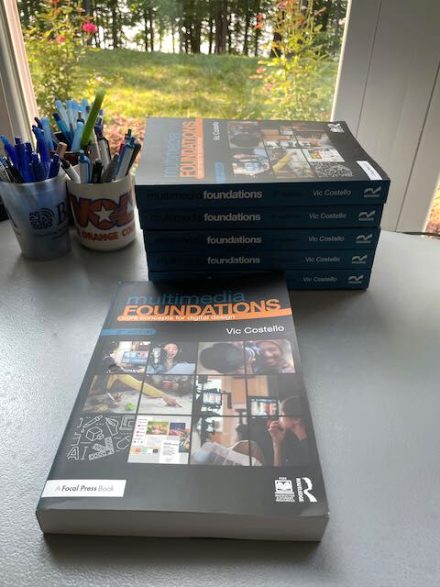The associate professor of cinema and televisions arts recently completed the third edition of “Multimedia Foundations: Core Concepts for Digital Design,” a comprehensive textbook that highlights the skills necessary to be an effective modern storyteller.
Following the release of the third edition of “Multimedia Foundations: Core Concepts for Digital Design,” Vic Costello said he feels strongly that his “fully updated” textbook has reached a new level.

“I always thought the third edition would be the best edition,” said the associate professor of cinema and televisions arts. “For the first edition, you are just trying to crank it out – and it isn’t close to perfect. And the second edition is a chance to advance the book and include material you may have overlooked. But with the third edition, and having years of experience using the book, this edition has an improved narrative flow. And the way it is structured, and how the content is presented, really helps lead you from each chapter to the next.”
Published in mid-July by Routledge Taylor & Francis Group, “Multimedia Foundations” is a comprehensive resource for students who want to become effective modern storytellers and have an interest in journalism, film production, animation and game design, interactive media, web and graphic design, and other areas of modern media. Presented in full color with hundreds of vibrant illustrations, the third edition highlights new sections on digital asset management and media workflows, design thinking, inclusive design, color theory, photography composition, interview and B-roll acquisition techniques, and editing stages and postproduction workflows.
The 502-page book is also accompanied by supplemental online resources, including a glossary of terms, chapter PowerPoints, and sample text banks.
While Costello oversaw most of the book’s content, writing 12 of the publication’s 14 chapters, Professor of Strategic Communications Qian Xu and Senior Lecturer in Journalism Kelly Furnas contributed two important chapters to a new interactive media section. Xu examined usability and user interface design, updating her chapter from previous editions. Furnas provided a deep dive into coding for web and mobile media, covering new ground for the publication.

“The book focuses on what I’ll call transferrable concepts – principles that don’t necessarily change over time. These topics are more evergreen. But this new edition, and its new content, were long overdue, and I am delighted to finally see it in print,” Costello said. “Admittedly, interactive media is not in my wheelhouse, so I brought in Qian, a nationally recognized expert in user design, and Kelly, who is an expert in coding and regularly teaches it. I needed that level of expertise for those chapters, and I’m so appreciative of their great work.”
Additionally, Senior Lecturer of Communication Design Randy Piland, a veteran photojournalist, contributed more than 30 images to illustrate ideal composition and exposure techniques.
Costello expressed excitement for the new textbook, which is widely used in Elon’s Creating Multimedia Content class – a required course in the School of Communications.
“There was a lot of thought and intentionality that went into the book, and it is great to have it in hand heading into the semester,” Costello said. “It was a significant undertaking, which required release time and work over the summer. It took a year of dedicated focus to get the third edition to the publisher on time. And I’m very thankful for the administrative support I’ve received along the way.”


